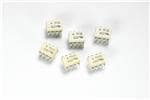Hi,
What is the best (and quite simple and not very expensive) way to isolate circuit1 from circuit3 by some buffer2?
The circuit1 is some voltage source with some load. The voltage on load might vary from 0.1 to 1 V, and the maximal current on load - up to 30 mA.
The circuit3 is some ADC input of the PC controlled board to measure the load voltage.

I have to “connect” the load to the ADC input to measure the load voltage, but I am unable to physically connect it. So I need some buffer circuit “2” based, may be, on optocoupler or galvanic (coil) to pass the voltage signal (current no matter) from the load to the ADC input. So the passed through “2”signal have to be equal or proportional to the voltage on load.
I have looked for the optical isolation by some optocoupler, but I haven’t found the suitable example of such circuit.
Give me, please some example(or reference) of the circuit to resolve my problem.
What is the best (and quite simple and not very expensive) way to isolate circuit1 from circuit3 by some buffer2?
The circuit1 is some voltage source with some load. The voltage on load might vary from 0.1 to 1 V, and the maximal current on load - up to 30 mA.
The circuit3 is some ADC input of the PC controlled board to measure the load voltage.
I have to “connect” the load to the ADC input to measure the load voltage, but I am unable to physically connect it. So I need some buffer circuit “2” based, may be, on optocoupler or galvanic (coil) to pass the voltage signal (current no matter) from the load to the ADC input. So the passed through “2”signal have to be equal or proportional to the voltage on load.
I have looked for the optical isolation by some optocoupler, but I haven’t found the suitable example of such circuit.
Give me, please some example(or reference) of the circuit to resolve my problem.

